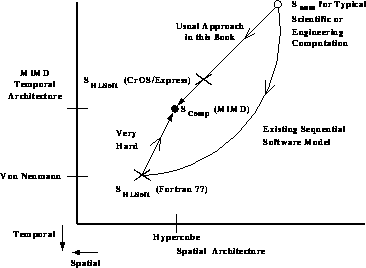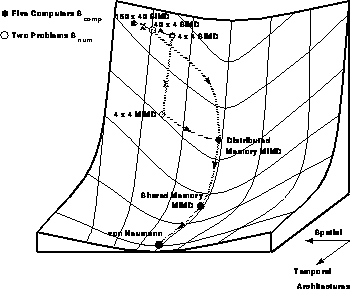





The complex system classification introduced in this chapter allows a precise formulation of the lessons of current research.
The majority of large scale scientific and engineering computations have synchronous or loosely synchronous character. Detailed statistics are given in Section 14.1 but we note that our survey suggests that at most 10% of applications are asynchronous. The microscopic or macroscopic temporal synchronization in the synchronous or loosely synchronous problems ensures natural parallelism without difficult computer hardware or software synchronization. Thus, we can boldly state that
for these problems. This quantifies our statement that ``Parallel Computing Works,''
where Equation 3.20 should be interpreted in the sense shown in Figure 3.13(b).
Roughly, loosely synchronous problems are suitable for MIMD and synchronous problems for SIMD computers. We can expand Equation 3.20 and write
The results in Equation 3.21 are given with more details in Tables 14.1 and 14.2. The text of this book is organized so that we begin by studying the simpler synchronous applications, then give examples first of loosely synchronous and finally asynchronous and compound problems.
The bold statements in Equations 3.20 and 3.21
become less clear when one considers software and the associated
software complex system  . The parallel software
systems CrOS and its follow-on Express were used in nearly all
our applications. These required explicit user insertion of message
passing, which in many cases is tiresome and unfamiliar. One can argue
that, as shown in Figure 3.14, we supported a high-level
software environment that reflected the target machine and so could be
effectively mapped on it. Thus, we show
. The parallel software
systems CrOS and its follow-on Express were used in nearly all
our applications. These required explicit user insertion of message
passing, which in many cases is tiresome and unfamiliar. One can argue
that, as shown in Figure 3.14, we supported a high-level
software environment that reflected the target machine and so could be
effectively mapped on it. Thus, we show  (CrOS) and
(CrOS) and
 (MIMD) close together on Figure 3.14. A
more familiar and attractive environment to most users would be a
traditional sequential language like Fortran77. Unfortunately,
(MIMD) close together on Figure 3.14. A
more familiar and attractive environment to most users would be a
traditional sequential language like Fortran77. Unfortunately,
and so, as shown in Figures 3.13(a) and 3.14, it is highly non-trivial to effectively map existing or new Fortran77 codes onto MIMD or SIMD parallel machines-at least those with distributed memory. We will touch on this issue in this book in Sections 13.1 and 13.2, but it remains an active research area.
We also discuss data parallel languages, such as High Performance Fortran, in Chapter 13 [Kennedy:93a]. This is designed so that

Figure 3.14: The Dusty Deck Issue in Terms of the Architectures of Problem,
Software, and Computer Complex Systems
We can show this point more graphically if we introduce a quantitative
measure M of the difficulty of mapping  . We represent
M as the difference in heights h,
. We represent
M as the difference in heights h,
where we can only perform the map if M is positive
Negative values of M correspond to difficult cases such as Equation 3.22 while large positive values of M imply a possible but hard map. Figure 3.15 shows how one can now picture the process of computation as moving ``downhill'' in the complex system architecture space.

Figure 3.15: Two Problems  and Five Computer Architectures
and Five Computer Architectures  in the Space-Time Architecture Classification of Complex Systems. An arrow
represents a successful mapping and an ``X'' a mapping that will fail without a
sophisticated compiler.
in the Space-Time Architecture Classification of Complex Systems. An arrow
represents a successful mapping and an ``X'' a mapping that will fail without a
sophisticated compiler.
This formal discussion is illustrated throughout the book by numerous
examples, which show that a wide variety of applications parallelize.
Most of the applications chapters start with a computational analysis
that refers back to the general concepts developed. This is finally
summarized in Chapter 14, which exemplifies the asynchronous
applications and starts with an overview of the different temporal
problem classes. We build up to this by discussing synchronous
problems in Chapters 4 and 6; embarrassingly
parallel problems in Chapter 7; loosely synchronous
problem with increasing degrees of irregularity in Chapters 8,
9, and 12. Compound problem classes-an asynchronous
mixture of loosely synchronous components-are described in
Chapters 17 and 18. The large missile tracking and
battle management simulation built at JPL (Figure 3.11b)
and described briefly in Chapter 18 was the major example of
a compound problem class within C P.
Chapters 17 and 19 indicate that we believe that this
class is extremely important in many ``real-world'' applications that
integrate many diverse functions.
P.
Chapters 17 and 19 indicate that we believe that this
class is extremely important in many ``real-world'' applications that
integrate many diverse functions.




